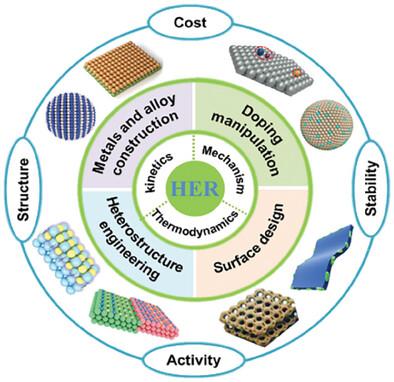当前位置:
X-MOL 学术
›
Adv. Energy Mater.
›
论文详情
Our official English website, www.x-mol.net, welcomes your
feedback! (Note: you will need to create a separate account there.)
Self-Supported Metallic Alkaline Hydrogen Evolution Electrocatalysts Tolerant for Ampere-Level Current Densities
Advanced Energy Materials ( IF 24.4 ) Pub Date : 2024-11-19 , DOI: 10.1002/aenm.202404077
Hao Xiong 1 , Rong Zhuang 1 , Bo Cheng 2 , Dengke Liu 1 , Yuxuan Du 1 , Hongyue Wang 1 , Ye Liu 1 , Fei Xu 1 , Hongqiang Wang 1
Advanced Energy Materials ( IF 24.4 ) Pub Date : 2024-11-19 , DOI: 10.1002/aenm.202404077
Hao Xiong 1 , Rong Zhuang 1 , Bo Cheng 2 , Dengke Liu 1 , Yuxuan Du 1 , Hongyue Wang 1 , Ye Liu 1 , Fei Xu 1 , Hongqiang Wang 1
Affiliation

|
Electrocatalytic water splitting is an attractive approach for large-scale hydrogen generation, critical for global carbon neutrality. However, the prevalent commercialized alkaline water electrolysis is generally conducted at low current densities due to sluggish kinetics and high overpotential, severely hampering high-efficiency hydrogen production. Exploration of hydrogen evolution reaction (HER) electrocatalysts that can reliably operate at ampere-level current densities under low overpotentials is thus a primary challenge. In contrast to extensive studies using powdery electrocatalysts, the self-supported metallic catalytic cathode has become a burgeoning direction toward ampere-level current densities, owing to their integrated design with intensive interfacial binding, high conductivity and mechanical stability with industrial tolerance/adaption. Recent years have witnessed tremendous research advances in designing self-supported metallic electrocatalysts. Therefore, this flourishing area is specially summarized. Beginning with the introduction to the theory and mechanism of alkaline HER, the engineering strategies on self-supported metallic electrodes are systematically summarized, including metal and alloy construction, heterostructure engineering, doping manipulation, and surface design. Meanwhile, particular emphasis is focused on the relationship between structure, activity, and stability under ampere-level HER. Finally, the existing challenges, requirements of industrial-scale application, and future direction for designing electrocatalysts are summarized, aiming to provide a better solution for industrial alkaline water electrolysis.
中文翻译:

自支撑金属碱性析氢电催化剂可耐受安培级电流密度
电催化分解水是一种有吸引力的大规模制氢方法,对全球碳中和至关重要。然而,由于动力学缓慢和高过电位,流行的商业化碱性水电解通常在低电流密度下进行,严重阻碍了高效制氢。因此,探索能够在低过电位下以安培级电流密度可靠运行的析氢反应 (HER) 电催化剂是一项主要挑战。与使用粉末状电催化剂的广泛研究相比,自支撑金属催化阴极已成为安培级电流密度的新兴方向,因为它们的集成设计具有强烈的界面结合、高导电性和机械稳定性以及工业耐受性/适应性。近年来,自支撑金属电催化剂的设计取得了巨大的研究进展。因此,特则对这个繁华的领域进行总结。从介绍碱性 HER 的理论和机理开始,系统总结了自支撑金属电极的工程策略,包括金属和合金结构、异质结构工程、掺杂操作和表面设计。同时,特别强调安培级 HER 下结构、活性和稳定性之间的关系。最后,总结了电催化剂设计存在的挑战、工业规模应用的要求和未来方向,旨在为工业碱性电解水提供更好的解决方案。
更新日期:2024-11-19
中文翻译:

自支撑金属碱性析氢电催化剂可耐受安培级电流密度
电催化分解水是一种有吸引力的大规模制氢方法,对全球碳中和至关重要。然而,由于动力学缓慢和高过电位,流行的商业化碱性水电解通常在低电流密度下进行,严重阻碍了高效制氢。因此,探索能够在低过电位下以安培级电流密度可靠运行的析氢反应 (HER) 电催化剂是一项主要挑战。与使用粉末状电催化剂的广泛研究相比,自支撑金属催化阴极已成为安培级电流密度的新兴方向,因为它们的集成设计具有强烈的界面结合、高导电性和机械稳定性以及工业耐受性/适应性。近年来,自支撑金属电催化剂的设计取得了巨大的研究进展。因此,特则对这个繁华的领域进行总结。从介绍碱性 HER 的理论和机理开始,系统总结了自支撑金属电极的工程策略,包括金属和合金结构、异质结构工程、掺杂操作和表面设计。同时,特别强调安培级 HER 下结构、活性和稳定性之间的关系。最后,总结了电催化剂设计存在的挑战、工业规模应用的要求和未来方向,旨在为工业碱性电解水提供更好的解决方案。

































 京公网安备 11010802027423号
京公网安备 11010802027423号